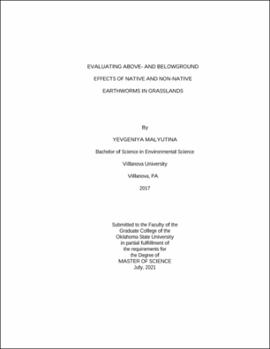| dc.description.abstract | Previous research has shown non-native earthworms can alter ecosystem function and structure by altering plant communities, soil dynamics, and soil microbial functional groups, including disruption of arbuscular mycorrhizal (AM) fungi, in North America. Compared to previously earthworm-free regions, few studies have investigated effects of non-native earthworms in regions where native earthworms are currently present, with even fewer on earthworm invasions in tallgrass prairies. We conducted complimentary field and growth-chamber mesocosm studies to assess potential effects of non-native earthworms on plants and plant-microbial interactions in tallgrass prairies in north-central Oklahoma. In our field study we assessed earthworm abundance and species composition, plant species composition and biomass, total soil microbial biomass, and relative abundance of soil microbial functional groups including intra- and extra-radical AM fungal abundance. In our mesocosm study we assessed the individual and combined effects of native and non-native earthworms on Andropogon gerardii production and soil microbial communities. At our field site we found both native (Diplocardia spp.) and non-native (Aporrectodea trapezoides) earthworms, with natives dominating earthworm abundances. Neither native nor non-native earthworm abundances were significantly associated with percent vegetation cover, vegetation biomass and richness, or soil microbial communities. However, greater numbers of total earthworms (native or native and non-native combined) were inversely related to native vegetation cover, including Aristida oligantha, and positively related to non-native vegetation cover, including Bothriochloa spp. Our mesocosm study found no relationship between native nor non-native earthworms and above- or belowground biomass or flowering, or the microbial community, including AM fungi. However, native earthworms alone influenced plant root structure differently than when native and non-native earthworms were both included, suggesting cross-species interactions. Potential mechanisms are unknown, requiring further research assessing additional variables, including nutrient availability. Our research suggests total abundance of earthworms, but not specific species groups, may influence vegetation composition in tallgrass prairies by reducing native and promoting non-native plant cover. However, because the vegetation community is linked to total earthworm abundances, widespread ecosystem effects may increase as non-native earthworm invasion continues. Thus, continued studies of earthworm effects in tallgrass prairies is crucial to monitor further alterations of this endangered ecosystem. | |
